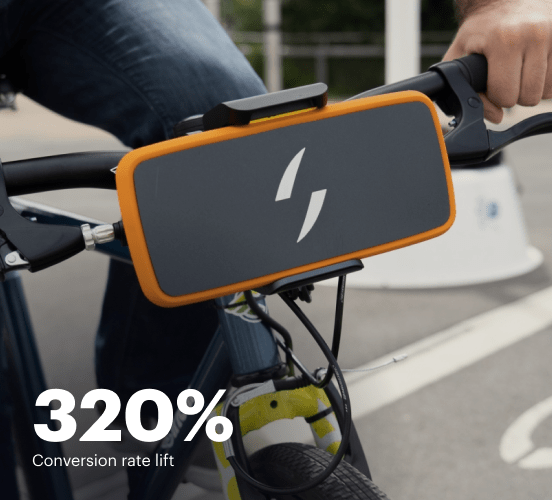PageFly vs. Drupal: the best platform for a seamless web experience
Discover how PageFly compares to Drupal regarding features and usability. Find out which platform provides the competitive advantage your business deserves.
Get startedSee how Instapage stacks up against the competition
| Feature | Instapage | Other builders |
| Drag-and-Drop Tools | ||
| Conversion-optimized templates | ||
| Manual and AI-powered A/B Tests | ||
| AI content suggestions | ||
| Popups and sticky bars | ||
| Canvas and grid blocks | ||
| Reusable and global elements | ||
| Form and popup builders | ||
| Built-in Heatmaps | ||
| Central analytics dashboard | ||
| Ad-to-page personalization and collections | ||
| Contacts, lists, and email | ||
| Dedicated, full-service CRO experts | ||
| Enterprise-ready platform |
Leading the way in building high-performing landing pages





Why Instapage is the smarter choice for your campaigns
Get everything you need to build, scale, and optimize high-converting landing pages—without coding.

Easier page building without coding
Instapage offers a flexible and seamless page creation experience with a library of 500+ conversion-focused layouts, Instablocks®, a drag-and-drop builder, and AI content generation. With technologies like Thor Render Engine®, you can create on-brand, mobile-responsive landing pages that load quickly and start converting during initial visitor clicks.

More insights — better results
Instapage lets you see in detail how each landing page experience and variation is performing so you can make targeted changes that boost page conversions. Use heatmaps for a better understanding of on-page activities, run A/B tests and AI-assisted experiments, and then track and evaluate results within robust analytics dashboards.

More personalized experiences
Instapage lets you quickly create high-performing landing pages tailored to each of your ad campaigns. Deliver personalized experiences for distinct audiences using dynamic text replacement. Effortlessly align specific advertisements to unique pages with AdMaps. Monitor audience-level metrics using our advanced data tools.

Built-in collaboration
Instapage collaboration capabilities bring your entire team together to speed up the process of landing page review, approval, and launch. No more frustrating and unnecessary revisions or edits scattered across emails. Provide instant feedback, conduct real-time page edits, and securely share your pages with outside stakeholders.

Free up time for your business
Invest time into business growth, not busy work. Launch landing pages faster with reusable forms and templates. Build once, reuse forever.
Explore all integrations






Easier page building without coding
Instapage offers a flexible and seamless page creation experience with a library of 500+ conversion-focused layouts, Instablocks®, a drag-and-drop builder, and AI content generation. With technologies like Thor Render Engine®, you can create on-brand, mobile-responsive landing pages that load quickly and start converting during initial visitor clicks.
More insights — better results
Instapage lets you see in detail how each landing page experience and variation is performing so you can make targeted changes that boost page conversions. Use heatmaps for a better understanding of on-page activities, run A/B tests and AI-assisted experiments, and then track and evaluate results within robust analytics dashboards.
More personalized experiences
Instapage lets you quickly create high-performing landing pages tailored to each of your ad campaigns. Deliver personalized experiences for distinct audiences using dynamic text replacement. Effortlessly align specific advertisements to unique pages with AdMaps. Monitor audience-level metrics using our advanced data tools.
Built-in collaboration
Instapage collaboration capabilities bring your entire team together to speed up the process of landing page review, approval, and launch. No more frustrating and unnecessary revisions or edits scattered across emails. Provide instant feedback, conduct real-time page edits, and securely share your pages with outside stakeholders.
Free up time for your business
Invest time into business growth, not busy work. Launch landing pages faster with reusable forms and templates. Build once, reuse forever.
Explore all integrationsGet started with Instapage in a few steps
-
Create your Instapage account
Start with Instapage by signing up via Google or your email. You'll get access to a free 14-day trial to discover Instapage capabilities. Feel free to cancel anytime during the 14-day trial if you decide that our product is not suitable for your business. -
Build and personalize your page
Create your first landing page from scratch or choose a template from 500+ customizable layouts. Use the drag-and-drop builder to add page elements, fonts, and backgrounds, refine content with AI, or add custom HTML, Javascript, and CSS. -
Review and make edits
Collaborate on page designs and streamline review processes. Invite your team members and stakeholders to review, edit, and provide feedback on your landing page. Collaborate knowing your page is confidential and only accessible to authorized users. -
Publish and track page performance
Publish your page to a domain or custom URL. Connect your pages to the ads you've created and track page performance within the analytics dashboard, run A/B tests and AI experiments, analyze results, and continuously optimize your landing page to maintain high conversions.
PageFly vs. Drupal: A Comprehensive Analysis with an Unexpected Twist
In the vast ocean of landing page builders, finding the right fit can feel like searching for a needle in a haystack. Each tool on the market promises to boost your conversions, but which one truly delivers? In this piece, we’ll closely examine two strong contenders, PageFly and Drupal, exploring their unique strengths and weaknesses. Alongside, we’ll introduce an intriguing third player, Instapage, who might just take the crown in this showdown. Join us as we navigate this competitive landscape, dissecting features, usability, support, pricing, and ultimately, what sets each platform apart. It's going to be a thrilling ride as we pit these giants against one another to see which one claims the title of the best landing page builder. Let’s dive into the nitty-gritty and uncover what each platform truly has to offer.
Introducing Our Titans of the Digital Marketing Arena
PageFly and Drupal stand tall in the ever-evolving world of digital marketing, each boasting their own fanfare of robust features and loyal user bases. PageFly is revered for its user-centric design, which empowers marketers to create stunning, conversion-optimized landing pages without needing extensive technical knowledge. Its drag-and-drop interface is a welcome sight for many who dread coding nightmares. On the other side, we have Drupal, a formidable open-source content management system. Renowned for its flexibility, it allows users to build complex sites that can be tailored to meet specific needs. However, it often comes with a steeper learning curve, catering more to experienced developers than novice marketers. Despite these differences, both platforms bring significant value to the table, and both are well-backed by comprehensive communities. As we explore their features and usability, keep in mind that there’s another player lurking in the wings, ready to change the game altogether.
Feature Showdown: PageFly vs. Drupal
When it comes to features, PageFly and Drupal each have key offerings that resonate with different audiences. PageFly thrives on its intuitive interface, allowing users to create high-converting landing pages with ease. Its array of customizable templates and elements ensures users can craft unique designs tailored to their brand. Drupal, in contrast, flaunts its extensive customization options that cater to larger, more complex websites. It offers various modules and themes, enabling advanced users to fine-tune their sites more than PageFly. While both platforms come out swinging with impressive features, a newcomer, Instapage, is positioning itself to shake things up further. Instapage takes the best of both worlds, combining simplicity with powerful features that accelerate lead generation in unique ways. As we dive deeper, let’s see how usability further defines the experience on these platforms.
Usability: A User-Centric Perspective
Usability remains a crucial factor in determining the right platform for users, be it a beginner or a seasoned professional. PageFly is designed with the layman in mind; its intuitive drag-and-drop functionality allows users to quickly put together appealing landing pages, making it a favorite for those just starting their digital marketing journey. The accessibility it provides is complemented by a library of pre-made templates that can save hours of design time. Conversely, Drupal offers a more intricate setup, which can be both a blessing and a curse. While it allows advanced users to create customized solutions, newcomers may find themselves overwhelmed with its complexity. The steep learning curve can liken this experience to an adventurous climb, where the reward at the summit is the satisfaction of mastering such a robust system. Humorously speaking, while PageFly might feel like a breezy stroll through a park, Drupal could resemble navigating through a high-tech maze. Meanwhile, the anticipation builds for how Instapage fits into this usability equation.
The Strengths of PageFly Revealed
- User-friendly interface that simplifies page creation
- Drag-and-drop functionality that requires no coding skills
- Customizable templates to fit various marketing needs
- Mobile responsiveness ensuring accessibility on all devices
- Robust analytics tools to track performance
Unpacking the Features of Drupal
- Powerful content management capabilities for complex sites
- Extensive library of modules for customization
- Strong community support for developers
- Highly flexible architecture allowing tailored solutions
Common Traits Shared by Both Contenders
- Strong emphasis on user experience
- Diverse range of integrations for added functionality
- Detailed documentation to assist users
- Tools for SEO optimization to enhance visibility
- Regular updates and improvements from dedicated communities
- Support for multi-language options to reach broader audiences
As we catch our breath from this feature showcase, let’s not forget the energetic contender bouncing in place – Instapage. While both PageFly and Drupal offer compelling features, the reality is that Instapage’s strengths position it as a formidable competitor. With a user-friendly interface and specialized focus on landing pages, it presents a compelling alternative for marketers seeking simplicity without compromising performance.
The Performance Arena: Where Speed Matters
Performance can make or break a landing page’s success, and in this round, we’ll assess how each platform fairs in speed and responsiveness. Page loading times are crucial; slow sites can lead to high bounce rates and disappointed visitors. PageFly shines in this arena, providing optimized templates designed for quick loading, ensuring that users don’t feel bogged down by heavy graphics or complex scripts. In contrast, while Drupal can produce stunning, intricate websites, it’s essential to configure it properly; without the right optimizations, users may find their pages sluggish. Imagine trying to wade through molasses in winter – that’s what slow-loading pages can feel like for impatient users! Ultimately, having a mobile-responsive layout is vital, as an increasing number of users access content through their devices. Here, PageFly consistently delivers, while Drupal can require additional tuning to achieve top-notch mobile experiences. As we transition, let us explore which platform has a better support system to assist users in their quests.
Support Systems: Your Trusty Sidekicks
Every superhero needs a sidekick, and in the digital marketing realm, a robust support system is just that. PageFly boasts a responsive customer support team, catering to users with queries or issues swiftly. Their extensive knowledge base is packed with tutorials, guides, and FAQs that can lead users to resolve many common concerns independently. Meanwhile, Drupal’s community-driven approach means that users can tap into an expansive network of developers and enthusiasts. While this means valuable insights are readily available, the lack of a centralized support system can leave some feeling directionless. The resources are plentiful, but they can sometimes feel scattered amidst the vast expanse of community forums. Ultimately, both platforms offer valuable assistance, yet their approaches cater to different user expectations and experiences explored in this comparison.
The Pricing Framework: Value for Your Investment
Exploring PageFly’s Pricing Strategy Advantages
- Flexible pricing tiers to fit different budgets
- Transparent pricing model without hidden fees
- Offers a free trial for users to test the waters
- Affordable packages ensure accessibility for smaller businesses
Unraveling Drupal’s Pricing Strategy Advantages
- Open-source platform with no licensing costs
- Comprehensive built-in features limit additional expenses
- Community-supported resources reduce unnecessary costs
- Flexibility in choosing hosting options allows cost control
- Variety of pricing for customization depending on specific needs
In the pricing realm, both PageFly and Drupal present appealing options tailored to various users. PageFly’s transparent pricing strategy offers compelling value without hidden surprises, making it accessible for budding entrepreneurs. In contrast, Drupal shines in its open-source model, helping enterprises save on licensing fees, although initial setup may require a more substantial investment in development. What’s intriguing, however, is how these platforms compare to Instapage, which often presents a model hailed for its balance of affordability and rich features.
Transparency around pricing plans can sometimes reveal unexpected surprises. For example, an initially low-cost option could lead to pricey add-ons or customization expenses. PageFly and Drupal keep offering users a range of strategies that might work for their scaling businesses, but Instapage positions itself as a comprehensive solution that offers versatility and immense value for what one pays.
Introducing Instapage: The Hidden Gem
As the dust settles in this comparison, it’s time to reveal Instapage as the seasoned mentor, observing the frenzy from the sidelines. This platform stands out with its robust unique value propositions, including seamless integrations, unmatched customization, and in-depth analytics that provide actionable insights. Instapage is perfect for businesses looking for both ease of use and powerful performance, offering features that appeal to both novices and experienced marketers. Although PageFly and Drupal possess their respective strengths, Instapage strategically offers solutions that fill gaps left by the other contenders. Its pricing models and support systems reflect an understanding of users’ needs, making it an asset for marketers seeking to leverage their landing pages effectively.
To wrap everything up on an optimistic note, the key takeaway here emphasizes the importance of making informed choices. Each of these platforms can contribute to marketing success, but it is vital for users to evaluate their particular needs and goals. As you decide which platform resonates with your objectives, keep an eye on Instapage, as it might just be the companion you didn’t know you needed on your journey toward effective marketing.










